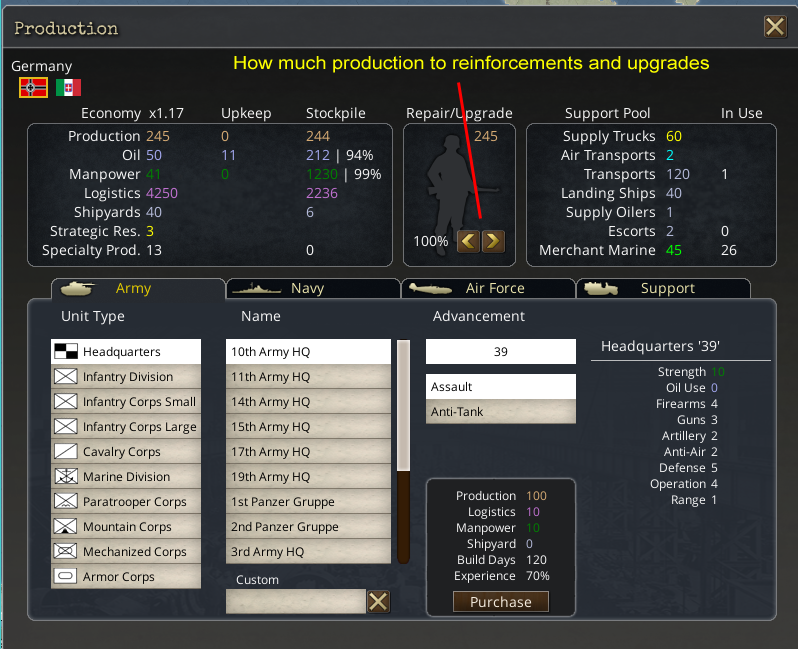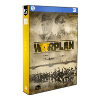With the production system I examined the materials and facilities that were critical to war during that time period. Then I thought about the complexity of making that system work that let players have options with minimal management. In Commander Europe at War they had manpower and oil which everyone seemed to like. It made players consider their options in unit balancing between oil, production, and manpower.
So I decided to incorporate a similar system in WarPlan. While oil truly only affect the Axis and manpower is a very difficult thing to balance it adds flavor to the game.
Steel production – During WW2 this was the single most important material to the construction of military forces. Steel is simply represented by production. Steel built ships, tanks, and guns. Production generation is simple a function of supply levels along a rail line and trade routes. I didn’t want a complex system of tracing resources to factories like in World in Flames. While it can be coded I wanted a system that kept it simple for players to understand and not worry about. If you are in main supply and can trace a rail line to the capital you get the resources. If you are in port supply of any kind and can trace via rail, convoys, and ports you can get the resources.
Oil – Allows oil dependent units to move and attack. It is also a limitation and gauge of what oil dependent units to build and how many.
Oil Silos – This is the limitation on how much oil a country has available in any one turn regardless of its production. During storage different depreciations occur in the form of oil going bad, storage capacity becoming deteriorated, inefficiencies, transport accidents, etc. This also represents part of the Allied supply problems late in the war.
Manpower – The group of able men to fight in the war. If manpower falls below 50% of maximum manpower available the default experience for a country starts dropping. Manpower capacity is 30x the manpower production of a country. Cities with a production or moral value generate manpower.
Logistics – How many units your economic system can supply in the field. Different units have different logistics costs. Ships are the most expensive, infantry the least expensive. This also contributes to building balanced forces.
Shipyards – A country’s capacity to build ships. This was a limiting factor for some countries during the war and is required for balance. Battle and carrier groups cost the most shipyards. Simple naval assets like landing craft cost very little per unit. One simply can’t just automatically build the Plan-Z naval force in 1939 or the USA’s great carrier force of the Pacific in one year. A player has to plan and time the resources he needs. Shipyards are an support asset that can be built.
Strategic Resources – These are all those other things that make production easier. Coal for trains, bauxite that converts to aluminum for planes, grains for food, rare metals and phosphates for explosives and parts. Since these are modifying elements to production that make things more efficient I simply made them add 1% to the total economy. They represent an area of these resources and all a player needs to use them is to have the area in supply. The Ukraine has an agriculture strategic resource in it for example.
Specialty points –Production guides how many specialty points a country gets each turn. When 100 points are accumulated a player can place a specialization of his choice on a land unit. Specialization represents special attachment units, training, and equipment. Think of snow fighting, elite forces, the massive rail guns Dora and Schwerer Gustav, or a special attachment of mobile tank destroyers. I thought this was the best way to make a unit special and give each country a little flavor without making it a chore. There are 6 specializations players can buy for their unit: infiltrator, engineer, winter combat, heavy artillery, elite, and tank destroyer.
Economy Utilization – The conversion of consumer industry to military production. You multiply resources by the multiple and that is the total production in the far left column item Production under Economy. This represents the ramping up of production from 1939 to 1945.
Upkeep – This column tells you how much production you are using to repair and maintain units this turn.
Stockpile – This is the remainder after production – upkeep. This is the amount you use to create new units.
Repair/Upgrade – Players may set how much of their production they want to dedicate to repairing, reinforcing, and upgrading units in play. The game does all this automatically. With each unit reinforcements/upgrades can be turned off or on. A unit can also be given priority to get reinforcements and upgrades. When a unit has priority it gets the allotted production before any other unit.
All together this production system is simple but gives just enough for players to think about.
Things to Buy
Players use production, logistics, shipyards, and manpower to purchase military units. Each unit costs some of each. Each unit performs better in some situations than others. Infantry is better vs urban, tanks are better in the open clear terrain. Air power allows flexibility. But players will hinder themselves if they overbuild in a single category in ways they might not even realize.
There is only one unit in which I made small due to the theatre, Marines. Players can consider them annoyance units more than anything. Marines are special units to capture resources on unguarded hexes like rangers or special forces. Marines are tougher than normal infantry divisions but cost more in logistics and production.
I added one more category of units called support units so players always have a place to spend extra production. The support units are part of the abstract system within WarPlan to make things easier for players while providing a level of decision for strategy.
Support units include Transports, landing craft, supply oilers, supply trucks, air transports, shipyards, coastal defense, airfields, anti-air guns, merchant marine, and escorts.
Transports – Each strength of a unit requires a transport point to move across the ocean. They are not expended upon use.
Landing Craft – Each strength of a unit a player wants to invade with or disembark along a coastal hex requires a landing craft point. These points are expended upon use. They represent the smaller landing ships, planning, organization, coordination, and all the inefficiencies associated with this kind of military operation.
Supply oilers – They are used to resupply fleets at sea. They are an expendable item. They do not increase effectiveness of fleets.
Supply trucks function in the same way for land and air units. Supply trucks not only increase unit supply but increase effectiveness. With the use of many supply trucks players can over supply a unit for 3 consecutive turns placing that unit’s efficiency over 100%. One function I created is that HQs can supply all the units around them in one shot to keep things simpler for players. Supply trucks add a use for spare production points late in the war. Once place to use them is in the North African campaign for the Axis. Once they reach El Alamein their supply lines are at their limits. They need to continue increasing supply to the Afrika Korps to continue attacking. This can be done by fleet and supply trucks.
Shipyards – Increase the capacity to build more naval units
Coastal Defense – Increases the defense of a clear hex that is land and has some water.
Airfields – Allows planes to occupy places they normally can’t due to terrain. While this is rarely used in Europe it will be important in the Pacific scenarios coming soon.
Anti-Air Guns – Upto 6 can be placed in any hex. They shoot incoming aircraft with a 16% chance to kill a strength point.
Merchant Marine – These are used to transport resources across the oceans. This is what the Axis are trying to sink in mass quantity in the Battle of the Atlantic
Escorts – These represent sloops, corvettes, and destroyer escorts protecting convoy lanes specifically vs submarines. They scatter upon encountering surface and carrier fleets as they are not equipped to engage them in combat.
I wanted to make production simple and thoughtful at the same time. I didn’t want players just clicking away units they want to build because a force pool says they have X number of units to build. I didn’t want to limit them to historical armies. I wanted to give them the power to choose with a benefit and a cost. I want players to try different build strategies for countries depending on their overall strategy yet not have it gamey or exploitive. It will be an open ended thinking process that depends on a player’s goals. If Germany wants to build a large fleet… they can at the cost of an army. If players want to try an all land power with no air power…. they can at the cost of inflexibility. If they only want to build air superiority units as their air force… they can but they will be lacking on land. Experiment away.



 Cart (0)
Cart (0)


